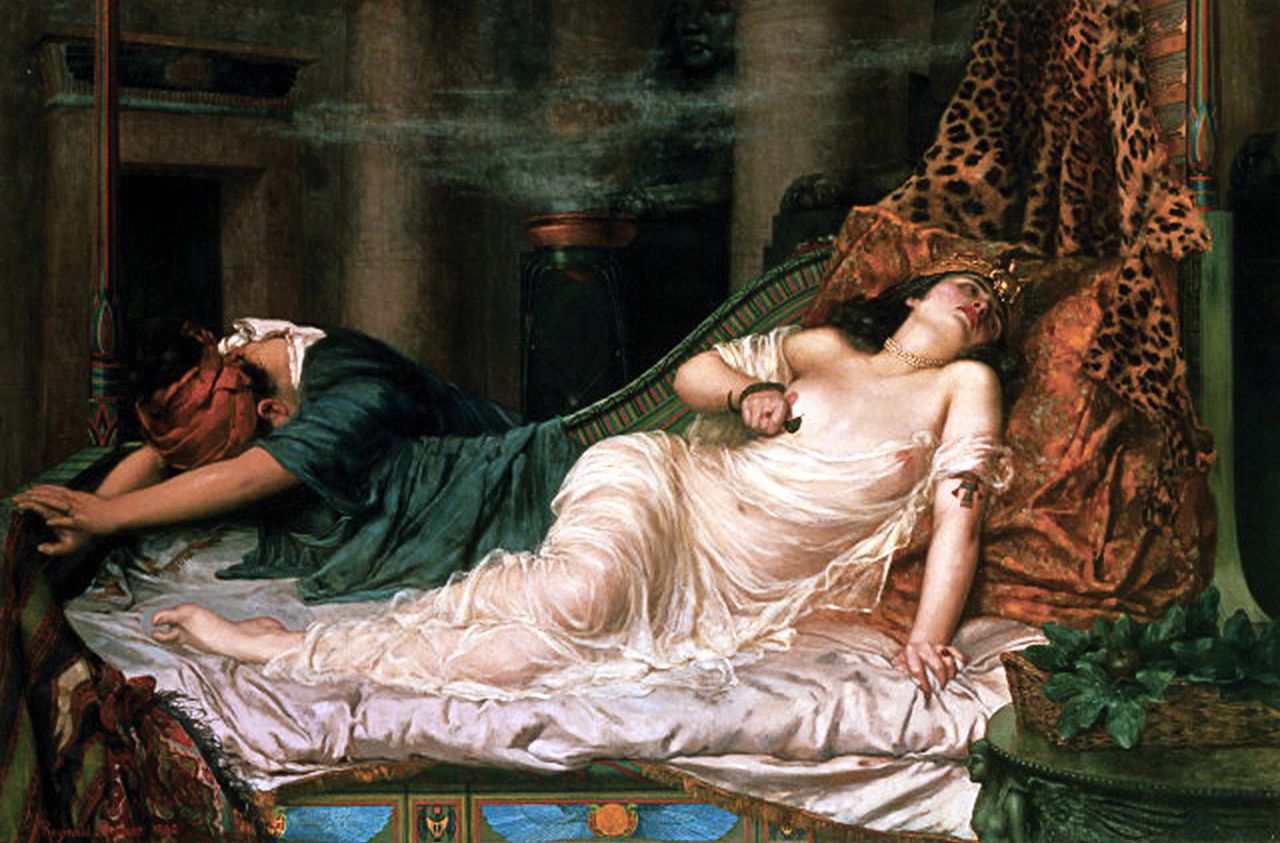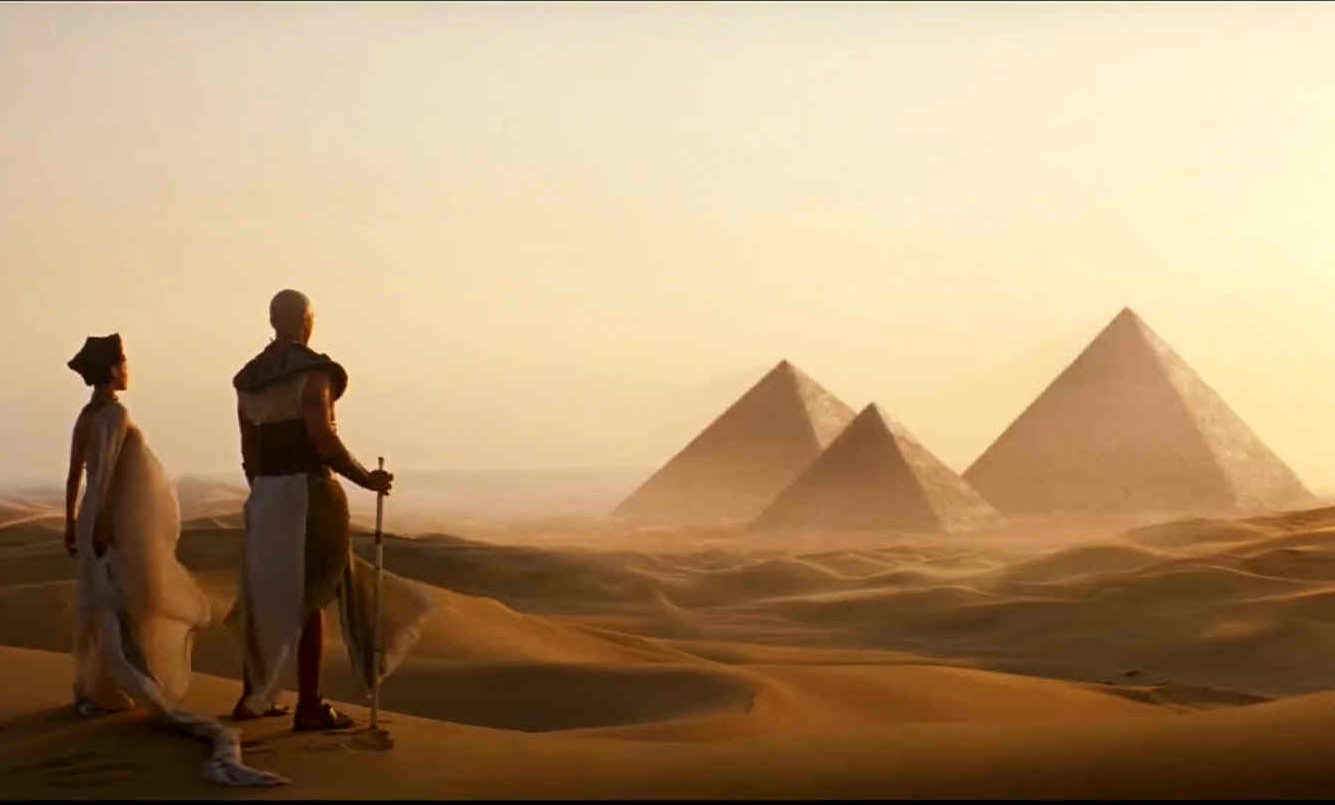
A
superb depiction of Cleopatra taking her own life, unlikely to have been by
the handling of a snake, but could well have been by an asp in a basket of
fruit. Most probably with a concoction of drugs to ease the pain.
Much
is written about the curses of the pharaoh's, warnings not to disturb the
graves of the dead kings and queens. But, one queen believed in the
afterlife and the power of thought and ambition's as yet unfulfilled, for a
better world. To be reunited with her lover, to see and experience all of that together.
And that queen was Cleopatra
VII Philopator.
There is no definitive evidence of a prophecy about
Cleopatra
VII Philopator being reborn, but there are some possible sources of inspiration for such a notion. One of them is the ancient Egyptian belief in the afterlife, which involved a complex journey through the underworld
(Duat)
and a judgment by Osiris, the god of the dead. The Egyptians believed that the souls of the righteous would be reborn indefinitely in a cycle of eternal life.
Cleopatra, as a Ptolemaic queen, associated herself with the goddess Isis, who was also the wife of
Osiris and the mother of Horus, the god of kingship. She also adopted aspects of the Greek goddess Aphrodite, who was the goddess of love and
beauty. By combining these two divine identities, Cleopatra may have hoped to secure her own immortality and legitimacy as a ruler.
Another possible source of inspiration is the Roman poet Virgil, who wrote the epic poem Aeneid in the late 1st century
BCE. The Aeneid tells the story of Aeneas, a Trojan hero who escaped the fall of Troy and founded
Rome. In the poem, Aeneas encounters
Cleopatra in the
underworld, where she is depicted as a furious and vengeful queen who led Egypt to ruin by allying with Mark Antony against Octavian, the future emperor
Augustus. Virgil portrays
Cleopatra as a contrast to Aeneas, who is praised for his piety and duty to his destiny. However, some scholars have suggested that Virgil also hints at a possible redemption for
Cleopatra, who may have been seen as a symbol of Egypt’s ancient glory and culture. According to this interpretation,
Cleopatra may have been reborn in spirit as a new queen of
Egypt, who would restore peace and prosperity to the land.
These are just some of the possible ways that a prophecy about Cleopatra being reborn could have originated or been interpreted. However, there is no conclusive proof that such a prophecy ever existed or was widely believed. It may be more accurate to say that
Cleopatra’s legacy has been reborn in various forms throughout history, as she has inspired many artists, writers, and leaders with her charisma, intelligence, and ambition.

ANCIENT
EGYPTIAN JOURNEY TO THE AFTERLIFE
Ancient
Egyptians theorized the passage to the
afterlife in a series of stages. The first phase was believed to encompass the vehicle of transportation, which would eventually direct their departed souls to immortality. Individuals were subjected to a multitude of passages; but the choice of route was not theirs, it was dependent on their status. The aspect that was most universally influential in determining what passage was taken was one's position among their leaders. Despite the differences between voyagers, beliefs concerning the afterlife were highly reliant on religious ideologies. For example, early people often used religion to understand, as well as relate to, natural occurrences since science had not yet defined everyday incidents. To demonstrate, there was no justification for the sun's orbit, so religious myths redefined and answered the questions prehistoric people had. Yet, since natural incidents were explained by religious beliefs, other realms of creed mimicked the natural patterns of life. For instance, the general ideology associated with the path to the underworld was believed that as night overshadowed the land, the deceased would begin their journey. And with the rising of the sun, a new day was not only thought to have begun, but a new life as well.
Boat passages to the underworld were strictly reserved for pharaohs who had died. The Egyptian sun god,
Ra, was believed to travel to the underworld by boat as the sun set. As a way to mimic Ra's daily expedition, the ancient people of Egypt would construct model boats, ranging in many sizes in which they would bury alongside their pharaohs. For example, next to the
Pyramid of
Khufu, researchers uncovered Khufu ship, a boat the size of traditional ships, which displayed not only the extreme devotion Egyptians had for their leader, but their dedication to obtaining eternity for all. In other words, a great deal of the requirements for the deceased to properly reach the underworld rested on the living. In order for the pharaoh to arrive at his final destination, his people had to construct a variety of boats to ensure his departure. As a result, communities had to come together to support each other, otherwise their perspective of immortality, as well as their beliefs, would end indefinitely. Therefore, commitment to helping others achieve eternity was a vital component to Egyptian culture, as demonstrated by the gallant boats buried with their rulers.
Additionally, an alternate vehicle for entrance to the underworld was the coffin. While kings often used coffins in addition to, or in substitution of the boat belief, everyday citizens had less choice. Therefore, this method was more universal while alluding to a different, more frequent path of entry. To compare, while passages by boat directed the deceased to the sun god Ra, coffins were thought to guide individuals to the sky goddess Nut. Each coffin was uniquely attributed to the person who rested in it. In other words, every coffin was subject to a variety of interpretations, all of which were intended to promote the deceased in obtaining eternity.
The path to the afterlife for the deceased was a difficult one. There were various gates, doors and pylons located in Duat, which the deceased would be required to pass. These gates had deities in charge of guarding them, sometimes there are more than 1,000 guardian deities listed, according to Ancient funerary texts. Every gate was guarded by a minor deity, commonly depicted as being zoo-anthropomorphic adorned with enormous threatening knives, who allowed access only to the souls capable of pronouncing the secret name of the deity themself, as a sort of "password". Therefore, the deceased would be buried with writings containing the names of these deities. A lot of these deities were given names that inspired terror and, above all, evoked their fearful powers. The names of these deities from time to time are disturbing, for instance, "He who dances in blood" and "Mistress Of Anger", or as harmless as "Mistress Of The Altar".
Ancient Egyptians saw Wepwawet as one who opened the ways to, and through, Duat, for the spirits of the dead. However, not all who died were presented with the opportunity to travel to the underworld. Since the living were obligated to ensure that the deceased could travel to the afterlife, it was also in their control to eliminate one's chance in achieving eternity. Therefore, the living had an array of options that prevented a second life to an unworthy individual who had died. The most famous included decapitation, which when executed, "killed a person twice". As a result, the second death associated with decapitation was also assumed to have annihilated the chance at another life. As noted in Egyptian texts, this instance was incredibly feared, but happened most often to those who rebelled or disobeyed the king.
JUDGMENT OF THE DEAD
To the ancient Egyptians, the judgment of the dead was the process that allowed the Egyptian gods to judge the worthiness of the souls of the deceased. Deeply rooted in the Egyptian belief of immortality, judgment was one of the most important parts of the journey through the afterlife. As such, many variations of judgment scenes appear in the Egyptian afterlife texts. Each soul that entered the afterlife was handled individually during judgment. Once the deceased finished their journey through the underworld, they arrived at the Hall of Maat. Here their purity would be the determining factor in whether they would be allowed to enter the Kingdom of
Osiris.
The deceased's first task was to correctly address each of the forty-two Assessors of Maat by name, while reciting the sins they did not commit during their lifetime. This process allowed the dead to demonstrate that they knew each of the judges’ names or Ren and established that they were pure, and free of sin. After confirming that they were sinless, the deceased was presented with the balance that was used to weigh their heart against the feather of
Maat. Anubis was the god often seen administering this test. If the deceased's heart balanced with the feather of Maat,
Thoth would record the result and they would be presented to Osiris, who admitted them into the Sekhet-Aaru. However, if their heart was heavier than the feather, it was to be devoured by the Goddess Ammit, permanently destroying the soul of the deceased, ceasing to exist.
LAKE OF FIRE
Fiery rivers and lakes in the underworld are mentioned in works such as the Coffin Texts and the
Book of the
Dead. Around their edges sit flaming braziers or baboons. Ra would pass through this lake on his journey through the Duat, renewing his boat. Chapter 126 of the Book of the Dead is associated with this vignette and the text is addressed to the "four baboons who sit in the prow of the Barque of Re." The lake was one of the dangers encountered on the journey through the Duat and had a dual nature. The baboons who guarded the pool were a force that could refresh and protect the deceased if they knew the correct recitation or destroy them if they did not. In the 21st Dynasty, human figures are depicted within the lakes. These represent enemies of the king or gods and their inclusion within the pools ensures their permanent destruction. In this way, the deceased could avoid meeting a similar fate, and be victorious over the forces of chaos like Ra. Am-heh, whose name means "devourer of millions" or "eater of eternity", is a hunting dog headed god from the underworld who lived in a lake of fire.
REBIRTH
There were numerous ways for Egyptians to secure their fate. Many of the actions Egyptian people took after death were to influence the god's decision in allowing for another life.
After judgement, entities were thought to return to the Mother Goddess' womb. During this stage, the soul meets its former body that is restored. To demonstrate, in the Book of Dead there is a series of lines that read as follows, "I unite your limbs, I hold your discharges together, I surround your flesh, I drive away the fluids of your decay, I sweep away your b3w, I wipe away your tears, I heal all your limbs, each being united with the other; I surround you with the work of the weaving goddess, I complete you and form you as Re." The belief continues as the nude being approaches the Goddess and enters her womb as her son. To compare, this dogma is deeply related to the birth of the sun god Ra, who enters the goddess's womb every night, and is reborn as the sun rises. Ra's relation to the afterlife is very connected through the religious components that justify the rising and setting of the sun.
Ultimately, the immortality desired by ancient Egyptians was reflected in endless lives. By doing worthy deeds in their current life, they would be granted a second life for all of eternity.
THE FIELD OF REEDS
Sekhet-Aaru, the "Field of Reeds", was the final destination for all souls who had been granted rebirth. This concept evolved in the Fifth Dynasty. Sekhet-Aaru was essentially thought to be paradise and encompassed this visualization. The Field of Reeds was visualized as a very lush region, filled with waterfalls among other natural wonders. Egyptian images, such as the Papyrus of Nebseni, depicted the land as being divided into numerous sections. Each division was imagined to resemble island structures, in which travel by boat is necessary.
Those who were granted access to the Field of Reeds included both gods and righteous souls. The fertility of the land was greatly emphasized as this possessed two of the major rewards in obtaining immortality: access to the Nile, and the ability to farm foods. As a result, the deceased ate and drank the same delicacies devoured by their gods. In turn, this promoted the belief that by obtaining immortality, individuals also accumulated aspects that resembled gods. Additionally, a third notable honor of residing in Sekhet-Aaru was the means of communication. The deceased were able to convey thoughts to one another, the gods, and those they had previously lost.
COFFINS AND BURIAL TOGETHER
Cleopatra and her Roman lover Mark Anthony were entombed together 2000 years ago because of her desire to
initiate an ancient prophecy. In this regard, Cleopatra negotiated with Octavian to allow her to bury
Mark Antony in Egypt.
The most logical explanation for engaging in such talks at a time of
considerable stress, is that she wanted to be buried with him because she wanted to reenact the legend of
Isis and Osiris.
This all depended on the quality of preparations, taking into account all eventualities, including the gradual sinking of parts of the port of
Alexandria, known to Cleopatra.
In order to fix herself and Anthony as rulers in the minds of the Egyptian people, she also worked hard to associate them with the myth of Isis and Osiris - a story that tells of a benevolent couple who ruled Egypt before being betrayed.
The purpose of her suicide, and the wish that Mark Antony would join her in death, was to enable the prophecy to come to pass.
She had no idea how this might be accomplished, but memorized all the names and incantations that she thought would be necessary on her path to being reborn.
She acted in good faith, and believing that she would come back into the
world, a better person to do great things. Important things for the world,
otherwise, why bother to come back at all.
Cleopatra, often known as the world's first celebrity, was the last of a long line to Ptolemaic rulers of Egypt - descended from Greek general
Alexander the
Great.
The death of Anthony is not quite as popularly reported. Though Antony died by his own hand, fatally stabbing himself, except that, Cleopatra had already taken poisons to commit suicide - including letting an asp bite her.
Thus, she witnessed Mark Antony read her letter, and plunge his dagger in a
ritual suicide.
Cleopatra's body was preserved as per her own instructions. That of Mark Antony was not so well cared for, but rather lumped together
hastily, her entourage having run out of time, in relocating her mummy to a
safer haven, that Octavian and those who came after him, might not break
with his word, and that if he did, he would be stymied.
Dealing with her list in order of
priority, her entourage first ensured that Cleopatra was preserved, her body
and organs preserved. All contained in a water-tight casket of exceptional
quality.

Her
prophesy come true. Cleopatra is reincarnated in the modern world.
“To our knowledge and information Cleopatra was buried in a tomb beside her palace, which is now submerged under the
Mediterranean
Sea.”
|


